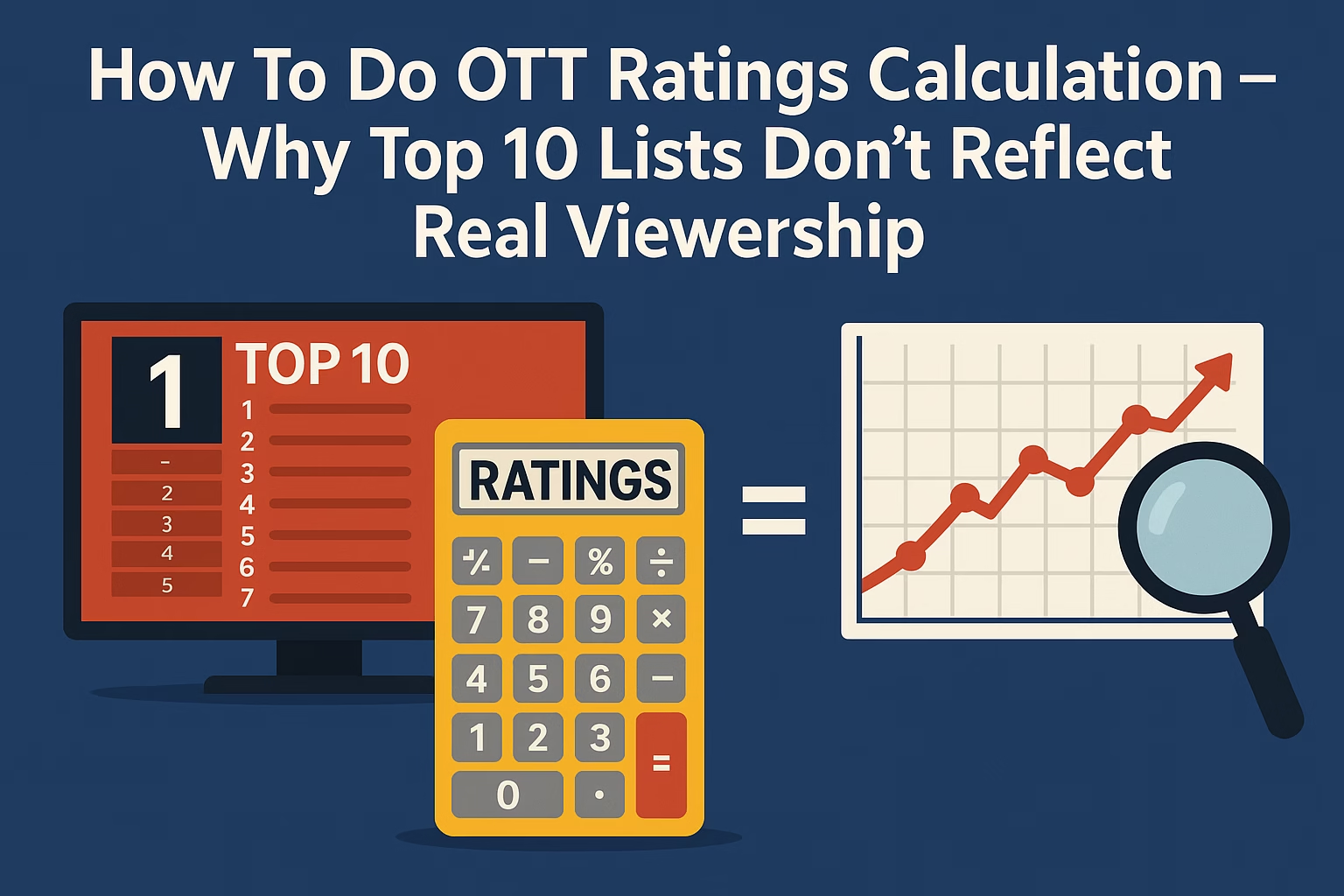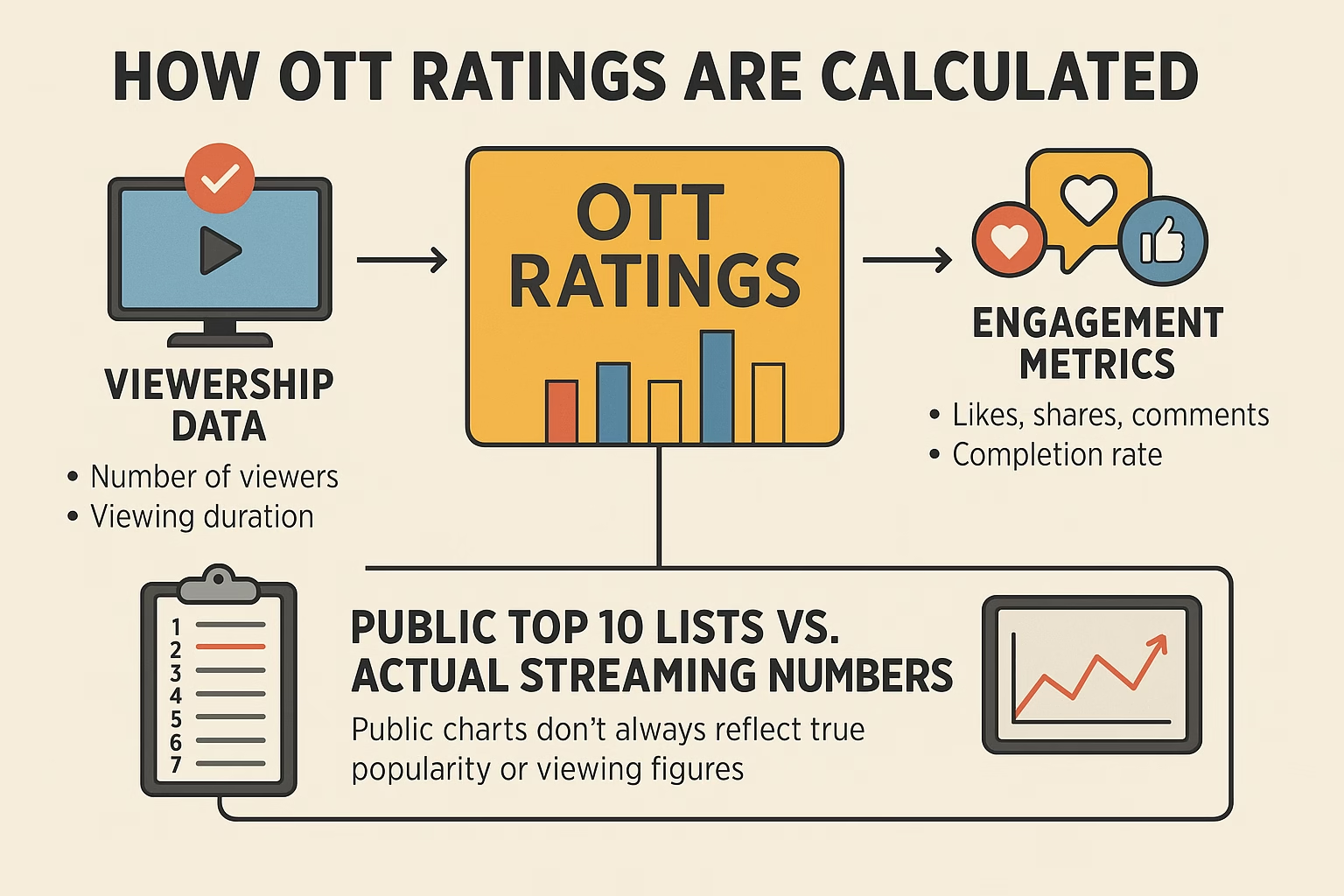Introduction
Ever wondered how a random show you’ve never heard of ends up on your OTT platform’s “Top 10 in India Today” list? Or why your favorite, buzz-worthy series doesn’t even show up? You’re not alone. The truth is — the way OTT ratings are actually calculated is far more complex, inconsistent, and often misleading than most viewers realize.

In this article, we’ll break down the OTT ratings calculation process in India and globally, uncover why these Top 10 lists don’t reflect actual viewership, and explain how advertisers, creators, and audiences are affected.
Whether you’re a curious viewer, an indie filmmaker, or a digital marketer — this deep dive will help you understand what’s really going on behind the screen.
Why the Hype Around OTT Ratings?
OTT platforms like Netflix, Prime Video, Disney+ Hotstar, and JioCinema are replacing TV in many households. With binge-worthy content dropping every week, these platforms are becoming the new battleground for audience attention.
So it’s no surprise that everyone—from studios and actors to advertisers and influencers—cares about OTT ratings calculation. It directly affects:
- What gets recommended
- What gets renewed or canceled
- What advertisers are willing to spend on
- What the next big “hit” is considered to be
But here’s the kicker: unlike TV, OTT platforms aren’t regulated by one standard rating system.
Who do OTT ratings calculation in India?
In India, there’s no central authority like BARC (used for TV ratings) that tracks or audits OTT viewership across all platforms. Instead, we have:
1. Self-Reported Data from Platforms
Netflix, Prime Video, and others often publish weekly or monthly top 10 charts. But here’s the catch:
- They define “views” however they want (e.g., 2 minutes watched = 1 view)
- They decide what to publish and when
- They do not share raw data or methodology
2. Third-Party Estimators
Services like Ormax Media, Chrome DM, and App Annie use:
- App installs & usage data
- Panel-based surveys
- AI modeling
But they don’t have access to internal platform data, which limits accuracy.
3. Public Tools like Google Trends & Social Media Mentions
While not official ratings, these offer insights into what’s trending, especially during major releases.
So, in a nutshell, OTT ratings calculation is a cocktail of private data, indirect metrics, and a lot of assumptions.

How OTT ratings calculation Get Done
Let’s break it down based on how most platforms (and 3rd parties) work:
🔹 Watch Time
The total minutes a piece of content is streamed. Platforms like Netflix now release watch-time stats instead of just “views.”
🔹 Start-Stop Rates
How many people start watching versus how many actually complete it? This indicates stickiness.
🔹 Average View Duration
For example, if 80% of people drop off after the first episode, it’s a red flag—even if total views are high.
🔹 Completion Rate
Especially for movies—how many watched till the end?
🔹 Repeat Views
Highly valuable. If users rewatch a show, it signals deeper engagement.
🔹 Search Behavior
This includes internal platform search as well as external platforms like Google.
🔹 Device & Region-Specific Data
Platforms often segment data by geography, time of day, and device used.
The problem? Each platform uses its own formula. There’s no standard definition of what counts as a “view.”
10 Most Dangerous Haunted Places in North India – PLEASE DON’T GO
What’s Wrong with the Top 10 Lists?
You open Netflix, see a movie at #1, watch it… and regret it. Why? Because the Top 10 doesn’t always reflect what’s best, just what’s being pushed or clicked on.
❌ Manipulation is Possible
- Platforms push certain content with banners or autoplay previews
- Even accidental clicks count toward rankings
❌ Short-Term Trends Over Long-Term Value
A show trending for 2 days after release might top the chart, even if it tanks later.
❌ Not Geographically Transparent
“Top 10 in India” may not reflect your city or age group at all.
❌ No User Ratings or Reviews
Unlike IMDb or Rotten Tomatoes, OTT Top 10 lists offer no audience feedback.
❌ Zero Accountability
Since platforms create their own charts, there’s no way to verify them.
How This Affects You — The Viewer
Here’s how faulty OTT ratings calculation impacts your experience:
- You waste time watching poor-quality content that ranked due to marketing, not merit
- You miss better shows buried under promoted ones
- You get misled into believing certain shows are more popular than they really are
Impact on Creators and Advertisers
- Indie filmmakers struggle to break into the charts due to opaque algorithms
- Good shows get canceled because internal metrics outweigh public sentiment
- Advertisers don’t know what they’re really paying for, especially on ad-supported platforms
The entire ecosystem suffers from this lack of transparency.
Is There a Better Way?
Yes—but it requires:
- Standardization — A unified system like BARC for OTT, which tracks real-time viewership
- Transparency — Platforms need to share how they calculate views, time watched, etc.
- User Reviews & Ratings — Direct feedback loop from users should influence visibility
- Third-Party Audits — Independent verification of Top 10 lists and viewership data
- Hybrid Metrics — Combine watch time, completion rate, reviews, and social buzz
Until then, your best bet is to trust word of mouth, user reviews, and platforms like IMDb, Reddit, or YouTube reviewers.
Global Attempts at Fixing the System
In the US and Europe, some attempts are being made:
- Netflix has begun releasing Top 10s based on “hours watched”
- Nielsen (US) now tracks OTT viewership using TV panel data
- BARC India is exploring the possibility of OTT measurement standards
But full-scale standardization is still years away.
So What Should You Do As a Viewer?
🔍 Don’t trust Top 10 blindly.
🗣️ Rely on community reviews (Reddit, Twitter, IMDb).
📺 Try new titles even if they’re not promoted.
🚫 Don’t equate ranking with quality.
🧠 And most importantly, know that OTT ratings calculation is still evolving.
Conclusion
The next time you see “#1 in India Today” plastered across a show, pause and ask: What does that actually mean?
Because behind that badge is a maze of unverified data, unclear metrics, and marketing influence.
Until platforms become more transparent and OTT ratings calculation becomes standardized, the Top 10 list will remain more of a marketing tool than a reliable viewer guide.
✅ TL;DR (Too Long, Didn’t Read)
- OTT platforms calculate ratings using inconsistent methods (watch time, views, etc.)
- Top 10 lists are not always trustworthy — they can be manipulated
- No single authority regulates OTT ratings calculation in India
- Third-party estimators exist, but they’re limited
- Creators, advertisers, and viewers all get affected by this lack of clarity
- Use IMDb, Reddit, and genuine user reviews to find quality content
- Push for better transparency in the OTT ratings calculation process
